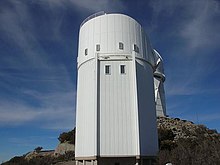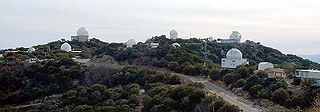
The Kitt Peak National Observatory (KPNO) is a United States astronomical observatory located on Kitt Peak of the Quinlan Mountains in the Arizona-Sonoran Desert on the Tohono Oʼodham Nation, 88 kilometers (55 mi) west-southwest of Tucson, Arizona. With more than twenty optical and two radio telescopes, it is one of the largest gatherings of astronomical instruments in the Earth's northern hemisphere.

Lowell Observatory is an astronomical observatory in Flagstaff, Arizona, United States. Lowell Observatory was established in 1894, placing it among the oldest observatories in the United States, and was designated a National Historic Landmark in 1965. In 2011, the Observatory was named one of "The World's 100 Most Important Places" by Time Magazine. It was at the Lowell Observatory that the dwarf planet Pluto was discovered in 1930 by Clyde Tombaugh.

The Large Binocular Telescope (LBT) is an optical telescope for astronomy located on 10,700-foot (3,300 m) Mount Graham, in the Pinaleno Mountains of southeastern Arizona, United States. It is a part of the Mount Graham International Observatory.

A refracting telescope is a type of optical telescope that uses a lens as its objective to form an image. The refracting telescope design was originally used in spyglasses and astronomical telescopes but is also used for long-focus camera lenses. Although large refracting telescopes were very popular in the second half of the 19th century, for most research purposes, the refracting telescope has been superseded by the reflecting telescope, which allows larger apertures. A refractor's magnification is calculated by dividing the focal length of the objective lens by that of the eyepiece.
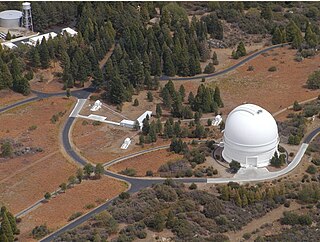
Palomar Observatory is an astronomical research observatory in San Diego County, California, United States, in the Palomar Mountain Range. It is owned and operated by the California Institute of Technology (Caltech). Research time at the observatory is granted to Caltech and its research partners, which include the Jet Propulsion Laboratory (JPL), Yale University, and the National Optical Observatories of China.

Steward Observatory is the research arm of the Department of Astronomy at the University of Arizona (UArizona). Its offices are located on the UArizona campus in Tucson, Arizona (US). Established in 1916, the first telescope and building were formally dedicated on April 23, 1923. It now operates, or is a partner in telescopes at five mountain-top locations in Arizona, one in New Mexico, one in Hawaii, and one in Chile. It has provided instruments for three different space telescopes and numerous terrestrial ones. Steward also has one of the few facilities in the world that can cast and figure the very large primary mirrors used in telescopes built in the early 21st century.

The National Optical Astronomy Observatory (NOAO) was the United States national observatory for ground-based nighttime ultraviolet-optical-infrared (OUVIR) astronomy. The National Science Foundation (NSF) funded NOAO to provide forefront astronomical research facilities for US astronomers. Professional astronomers from any country in the world could apply to use the telescopes operated by NOAO under the NSF's "open skies" policy.

The Magellan Telescopes are a pair of 6.5-metre-diameter (21 ft) optical telescopes located at Las Campanas Observatory in Chile. The two telescopes are named after the astronomer Walter Baade and the philanthropist Landon T. Clay. First light for the telescopes was on September 15, 2000 for the Baade, and September 7, 2002 for the Clay. A consortium consisting of the Carnegie Institution for Science, University of Arizona, Harvard University, the University of Michigan and the Massachusetts Institute of Technology built and operate the twin telescopes. The telescopes were named after the sixteenth-century Portuguese explorer Ferdinand Magellan.

The Isaac Newton Telescope or INT is a 2.54 m (100 in) optical telescope run by the Isaac Newton Group of Telescopes at Roque de los Muchachos Observatory on La Palma in the Canary Islands since 1984.
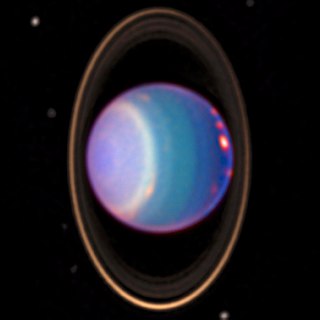
The Near Infrared Camera and Multi-Object Spectrometer (NICMOS) is a scientific instrument for infrared astronomy, installed on the Hubble Space Telescope (HST), operating from 1997 to 1999, and from 2002 to 2008. Images produced by NICMOS contain data from the near-infrared part of the light spectrum.

Siding Spring Observatory near Coonabarabran, New South Wales, Australia, part of the Research School of Astronomy & Astrophysics (RSAA) at the Australian National University (ANU), incorporates the Anglo-Australian Telescope along with a collection of other telescopes owned by the Australian National University, the University of New South Wales, and other institutions. The observatory is situated 1,165 metres (3,822 ft) above sea level in the Warrumbungle National Park on Mount Woorat, also known as Siding Spring Mountain. Siding Spring Observatory is owned by the Australian National University (ANU) and is part of the Mount Stromlo and Siding Spring Observatories research school.
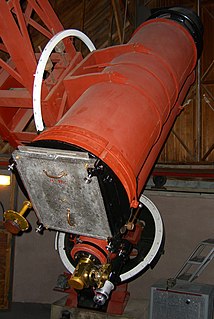
An astrograph is a telescope designed for the sole purpose of astrophotography. Astrographs are mostly used in wide-field astronomical surveys of the sky and for detection of objects such as asteroids, meteors, and comets.
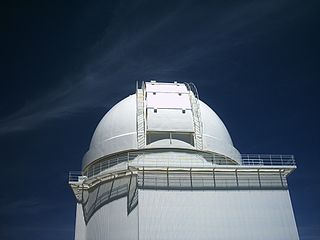
The Calar Alto Observatory is an astronomical observatory located in Almería province in Spain on Calar Alto, a 2,168-meter-high (7,113 ft) mountain in the Sierra de Los Filabres range.
Leuschner Observatory, originally called the Students' Observatory, is an observatory jointly operated by the University of California, Berkeley and San Francisco State University. The observatory was built in 1886 on the Berkeley campus. For many years, it was directed by Armin Otto Leuschner, for whom the observatory was renamed in 1951. In 1965, it was relocated to its present home in Lafayette, California, approximately 10 miles (16 km) east of the Berkeley campus. In 2012, the physics and astronomy department of San Francisco State University became a partner.
For the mountains in Tajikistan, see the Fann Mountains.

The C. Donald Shane telescope is a 120-inch (3.05-meter) reflecting telescope located at the Lick Observatory in San Jose, California. It was named after astronomer C. Donald Shane in 1978, who led the effort to acquire the necessary funds from the California Legislature, and who then oversaw the telescope's construction. It is the largest and most powerful telescope at the Lick Observatory, and was the second-largest optical telescope in the world when it was commissioned in 1959.
The United States Naval Observatory Flagstaff Station (NOFS), is an astronomical observatory near Flagstaff, Arizona, US. It is the national dark-sky observing facility under the United States Naval Observatory (USNO). NOFS and USNO combine as the Celestial Reference Frame manager for the U.S. Secretary of Defense.

Nicholas Ulrich Mayall was an American observational astronomer. After obtaining his doctorate from the University of California, Berkeley, Mayall worked at the Lick Observatory, where he remained from 1934 to 1960, except for a brief period at MIT's Radiation Laboratory during World War II.

The Nicholas U. Mayall Telescope, also known as the Mayall 4-meter Telescope, is a four-meter reflector telescope located at the Kitt Peak National Observatory in Arizona and named after Nicholas U. Mayall. It saw first light on February 27, 1973, and was the second-largest telescope in the world at that time. Initial observers included David Crawford, Nicholas Mayall, and Arthur Hoag. It was dedicated on June 20, 1973 after Mayall's retirement as director. The mirror has an f/2.7 hyperboloidal shape. It is made from a two-foot thick fused quartz disk that is supported in an advanced-design mirror cell. The prime focus has a field of view six times larger than that of the Hale reflector. It is host to the Dark Energy Spectroscopic Instrument. The identical Víctor M. Blanco Telescope was later built at Cerro Tololo Inter-American Observatory, in Chile.
